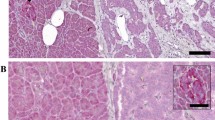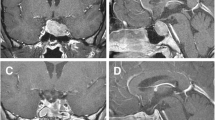Abstract
Objective: Expression of peroxisome proliferator-activated receptor (PPAR)γ in normal pituitary seems to be restricted to ACTH-secreting cells. The aim of the study was to evaluate the expression of PPARγ in normal human pituitary tissue and to study its localization in the pituitary secreting cells. Materials and methods: Normal pituitary tissue samples were obtained form 11 patients with non-secreting adenoma who underwent surgical excision of the tumor. Expression of PPAR? was evaluated by immunostaining and western blotting; localization of PPAR? in each pituitary secreting cell lineage was evaluated by double immunofluorescence using confocal microscopy. Pituitary non-functioning adenomas served as Controls. Results: PPARγ was highly expressed in all pituitary samples with a (mean±SD) 81±6.5% of stained cells; expression of PPARγ was confirmed by western blotting. Non-functioning pituitary adenomas had 74±11% PPAR? positive cells. Expression of PPARγ was either in cytoplasm or nuclei. In addition, treatment of GH3 cells, with a PPARγ ligand was associated with traslocation of the receptor from cytoplasm into the nucleus. Double immunostaining revealed that every pituitary secreting cell (GH, TSH, LH, FSH, PRL and ACTH) had PPARγ expressed. Discussion: The present study demonstrated that PPARγ is highly expressed in every normal pituitary secreting cell lineage. It can translocate into the nucleus by ligand binding; however, its role in pituitary hormone regulation remains to be elucidated.
Similar content being viewed by others
References
Desvergne B, Wahli W. Peroxisome proliferator activated receptors: nuclear control of metabolism. Endocr Rev 1999, 20: 649–88.
Rangwala SM, Lazar MA. Peroxisome proliferator-activated receptor gamma in diabetes and metabolism. Trends Pharmacol Sci 2004, 25: 331–6.
Lowell BB. PPARγ: an essential regulator of adipogenesis and modulator of fat cell function. Cell 1999, 99: 239–42.
Li AC, Brown KK, Silvestre MJ, Willson TM, Palinski W, Glass CK. Peroxisome proliferator-activated receptor gamma lig-ands inhibit development of atherosclerosis in LDL receptor-deficient mice. J Clin Invest 2000, 106: 523–31.
Sporn MB, Suh N, Mangelsdorf DJ. Prospects for prevention and treatment of cancer with selective PPARgamma modulators (SPARMs). Trends Mol Med 2001, 7: 395–400.
Demetri GD, Fletcher CDM, Mueller E, et al. Induction of solid tumor differentiation by the peroxisome proliferator-activated receptor-? ligand troglitazone in patients with liposarcoma. Proc Natl Acad Sci USA 1999, 96: 3951–6.
Kubota T, Koshizuka K, Williamson EA, et al. Ligand for per-oxisome proliferator-activated receptor ? (troglitazone) has potent antitumor effect against human prostate cancer both in vitro and in vivo. Cancer Res 1998, 58: 3344–52.
Evans RM, Barish GD, Wang YX. PPARs and the complex journey to obesity. Nat Med 2004, 10: 355–61.
Zander T, Kraus JA, Grommes C, et al. Induction of apop-tosis in human and rat glioma by antagonist of the nuclear receptor PPARgamma. J Neurochem 2002, 81: 1052–60.
Ohta K, Endo T, Haraguchi K, et al. Ligands for peroxisome proliferator-activated receptor gamma inhibit growth and induce apoptosis of human papillary thyroid carcinoma cells. J Clin Endocrinol Metab 2001, 86: 2170–7.
Desvergne B, Michalik L, Whali W. Be fit or be sick: peroxi-some proliferator-activated receptors are down the road. Mol Endocrinol 2004, 18: 1321–2.
Moller DE, Berger JP. Role of PPARs in the regulation of obesity-related insulin sensitivity and inflammation. Int J Obes Relat Metab Disord 2003, 3: S17–21.
Heaney AP, Fernando M, Yong WH, Melmed S. Functional PPAR-gamma receptor is a novel therapeutic target for ACTH-secreting pituitary adenomas. Nat Med 2002, 8: 1281–7.
Heaney AP, Fernando M, Melmed S. PPAR-gamma receptor ligands: novel therapy for pituitary adenomas. J Clin Invest 2003, 111: 1381–8.
Bogazzi F, Ultimieri F, Raggi F, et al. PPARγ inhibits GH syntesis and secretion and increases apoptosis of pituitary GH-secreting adenomas. Eur J Endocrinol 2004, 150: 863–75.
Ambrosi B, Dall’Asta C, Cannavo S, et al. Effects of chronic administration of PPAR-gamma ligand rosiglitazone in Cushing’s disease. Eur J Endocrinol 2004, 151: 173–8.
Cannavo’ S, Ambrosi B, Chiodini I, et al. Baseline and CRH-stimulated ACTH and cortisol levels after administration of the peroxisome proliferator-activated receptor-gamma lig-and, rosiglitazone, in Cushing’s disease. J Endocrinol Invest 2004, 27: RC8–11.
Shibuya A, Wada K, Nakajima A, et al. Nitration of PPARg inhibits ligand-dependent translocation into the nucleus in a macrophage-like cell line, RAW 264. FEBS Letters 2002, 525: 43–7.
Author information
Authors and Affiliations
Rights and permissions
About this article
Cite this article
Bogazzi, F., Russo, D., Locci, M.T. et al. Peroxisome proliferator-activated receptor (PPAR)γ is highly expressed in normal human pituitary gland. J Endocrinol Invest 28, 899–904 (2005). https://doi.org/10.1007/BF03345321
Accepted:
Published:
Issue Date:
DOI: https://doi.org/10.1007/BF03345321




